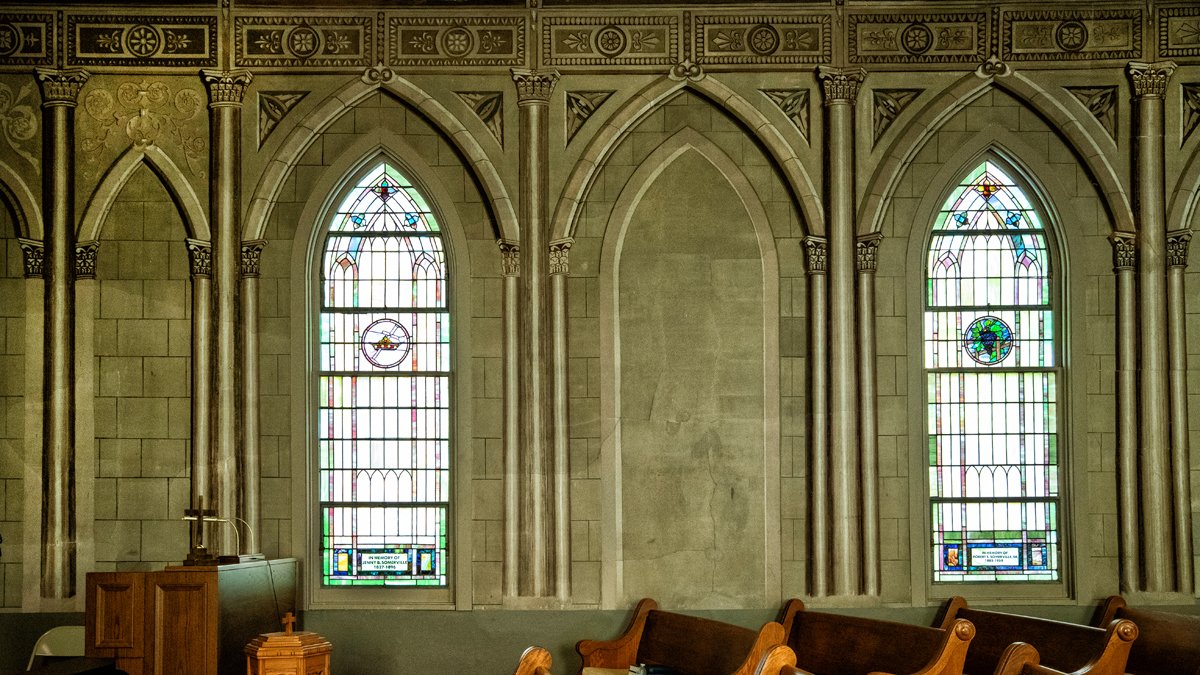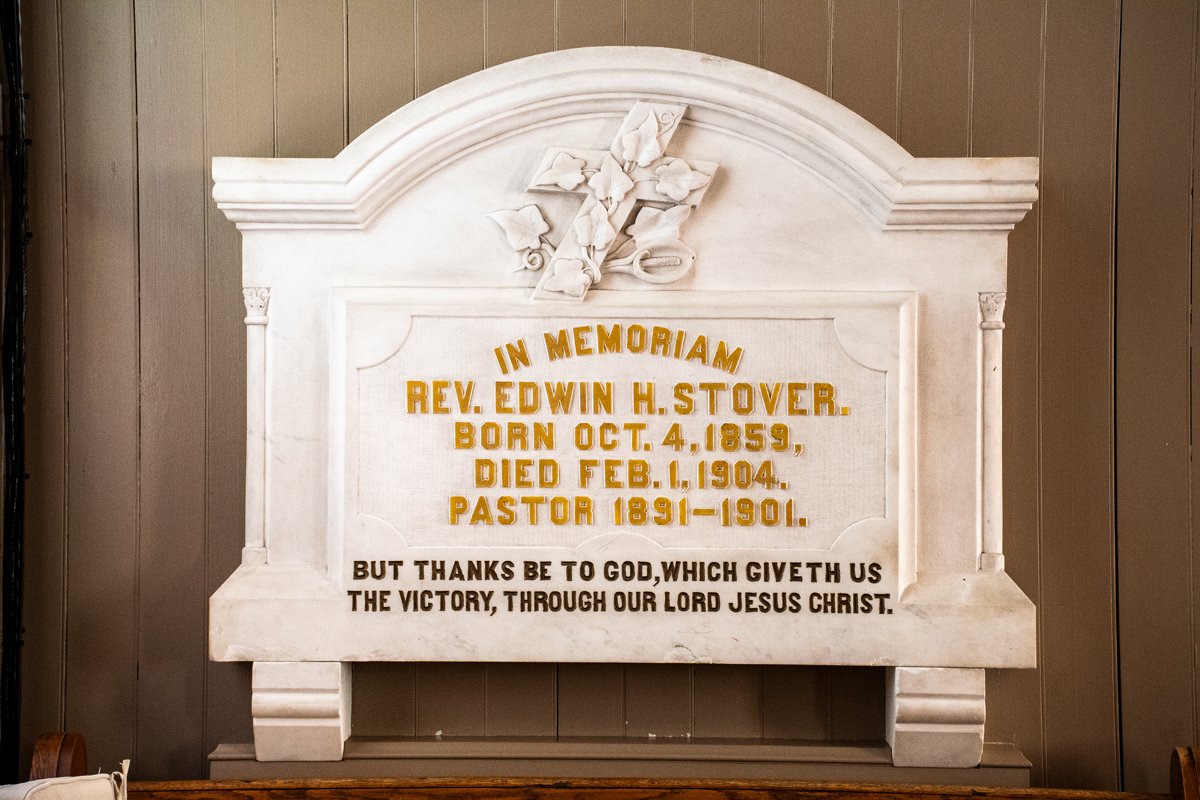Mitchells Presbyterian Church
A historic country church, a hobo painter, architectonic themed murals, and an artist who preserves the work of other artists. Seldom have I encountered so much information and history from a visit.
In December of 2022 I had been hired to document a meeting of concerned citizens about preserving the school, post office and general merchandise store, and home at Lahore, Virginia. On my way back from that assignment I was just wandering my way home, and admiring the view of the mountains, when I spotted what I initially thought was a silo. I have a special affinity for farms, barns, silos and such so I took a turn off the Zachary Taylor Highway onto Mitchell Road. I fully expected to find a place of agricultural productivity; imagine my surprise when I came upon a 19th century church.
This was the steeple that, from a distance, I mistook as a possible silo. No one has ever accused me of having eyes like an eagle.
Entering the church grounds from their parking lot this is your first view of the church and grounds. That mill, or grind, stone intrigued me. I wondered why it was there, and if it had any theological significance.
Typically a millstone was used in context to a warning.
"Two women shall be grinding at the mill, the one shall be taken and the other left" (Matt. 24:41) You don't want to find yourself grinding alone...
A millstone was such an integral part of ancient culture, that the Mosaic Law forbade taking someone’s millstone in pledge (Deuteronomy 24:6).
And anyone who "causes one of these little ones who believe in Me to stumble..." might find themselves tossed into the sea with one of these things tied to them.
Turns out, according to a church member, "It is a grind stone! It was historically the community grindstone, housed on the church property for Mitchells Station (the original name for Mitchells, VA).”
Like many older churches with graveyards, the headstones and memorials tend to be fascinating. And yes, I did think of chess pieces when I shot this.
What’s the difference between a cemetery and a graveyard? Well a graveyard adjoins a church, can be found on the church property. As graveyards started to become filled to capacity, cemeteries became the location, not necessarily affiliated with a church or religious institution, where the deceased could be laid to rest.
These headstones are works of art in themselves. If you walked around them you'd see information on more than one side.
Here you can see how close the relationship is between the graveyard and the church. It’s as if they are watching over each other.
The church was built, under the ministry of Rev. John P. Strider, in the “Carpenter Gothic” style, very popular in 1879. The congregation was originally the Rapidan Church formed in 1867, and renamed in 1879 to Mitchells Presbyterian Church.
According to the website for Mitchells Presbyterian Church, “The present congregation emerged as the fruit of fervent, evangelistic preaching during the Second Great Awakening (1785-1837), a great revival movement that swept the evangelical world. In 1818 Samuel Davies Hoge and later other Presbyterian ministers began to minister in a free church with those of other denominations in Mitchells.” ( https://www.mitchellspresbyterian.org/about-us/the-oddenino-murals/ )
It’s a one story building, on a brick foundation (which you can see), and like many country churches, is comparatively small compared to the brick and glass mega buildings popular today. It’s dimensions are 30 feet wide and 50 feet deep. But many people are amazed at how “big” it is when you enter.
Surprised? So was I and many, many others. It’s like you’re in a European cathedral. The trompe-l’oeil fresco which gives this effect was added over a seven year period (1892 - 1899) by an Italian immigrant, named Joseph Dominick Phillip Oddenino. His story is as interesting as his art work. Born in Chieri, Torino, Italy, in 1831 he immigrated to America. According to the Society of Architectural Historians:
"Although from the exterior this recently restored, small wooden Gothic Revival structure seems tame, the interior is extraordinary. A complex series of trompe l'oeil frescoes transform it into a masonry Gothic/Renaissance structure with clustered and twisted columns, arches, cornices, coffered ceiling, quatrefoils, and other architectural details, seemingly straight from Italy. It remains the best surviving work of an Italian immigrant—sometimes termed the “hobo painter.”
( https://sah-archipedia.org/buildings/VA-01-PI8 )
He was a master of a style of painting known as trompe-l’oeil, or “deceive the eye.” As you view the photographs of the interior consider how you think you’re looking at columns and arches, and architectural elements that are indeed three dimensional.
But…they’re not.
How often do you sit in a church and look up to see how beautiful it has been designed?
Look at the detail.
This is a corner of the chapel. The “converging lines” are the result of being shot in camera with a wide angel lens. When you visit these architectural lines will be as straight as that American flag in the center.
Remember that all that you see is painted, not the work of a stonemason.
Look at the incredible attention to detail, and the mastery of light and shadows.
This close up doesn’t do the work justice - but you can see how Oddenino used shadow and light to create a three dimensional work of art.
Consider the attention to detail and how long it took to create this.
Not to overlook the delicate stained glass windows and memorials to members. There are several of these - one at each window.
I’m not certain of this, but I think Rev. Stover would have been the pastor during the time Oddenino was working on this project.
Tom Thomas is an artist who restores and preserves the work of other artists. He’s been an invaluable resource for me.
“ There are numerous interesting stories associated with this mural. It’s particularly interesting how Oddenino utilized perspective. The trompe l’oeil coffered ceiling appears to shrink at the front of the sanctuary. The “horizon line” from which all of the angles emanate is unusually high at 158”. Both of these “fool the eye” tricks make the sanctuary feel larger than it is. The entire illusion is designed to grab the viewer when they first enter the room. This architectonic mural is made up of five basic earth tones from light to dark and applied so as to look 3 dimensional . The person entering the room becomes the “light source” as the light leading edge faces the viewer with the shadow edge appearing on the opposite edge. Oddenino probably worked from a built up temporary floor and spent about 7 years on this work. Sometimes he slept at the church and sometimes he hitched a ride south to his home west of Rapidan on the nearby railway. This is probably how he earned the name of “the hobo artist.”
Tom’s work and more information on this restoration for Mitchells Church and other projects can be found here:
https://finelinearchdetail.com/historic-paintwork
And Tom’s son is carrying on the family tradition.
Probably the greatest attributions and accolades for Oddenino’s artwork are the many people of the congregation and visitors who have commented on the posts in Facebook. And I personally want to thank Tom Thomas for his input as an artist and historian, and Larry and Linda Brooks who allowed me entrance to the interior last May and graciously hosted me at their home.
The church has a Facebook page also: https://www.facebook.com/MitchellsPres/
Here are just a few of those comments:
Paula Saifer: I recognized the name of the church. I have a recollection of attending with your Mama, Nanny Mack, my Mom when we would visit.
Vickie Wallace: Please return and visit the church again. My husband and I visited in 1993 to see the unique sanctuary. We return every week to see the people and feel the warmth and love they extend.
Patricia O’Bryant Hawkins: Great picture of my church! Thanks for posting. I love seeing this church every day!
Debbie Becker: This is the first church my kids attended they went on sundays with their Granny Marsh
Rita Somerville: Beautiful church and the people are the best.
Kenneth Marsh: As A child we were there each and every Sunday lots of memories.
Kay Beazley: The interior is a beautiful work of art!
Kaye Inskeep: I am Kaye Barfield born and raised on the farm surrounding the church...still attend this amazing place
Jon Busch: I know an Oddenino family member from high school and college. This is her direct ancestor. The Oddenino family of this amazing painter is still in Virginia!! Beautiful and unique ceiling paintings and beautiful church!



















